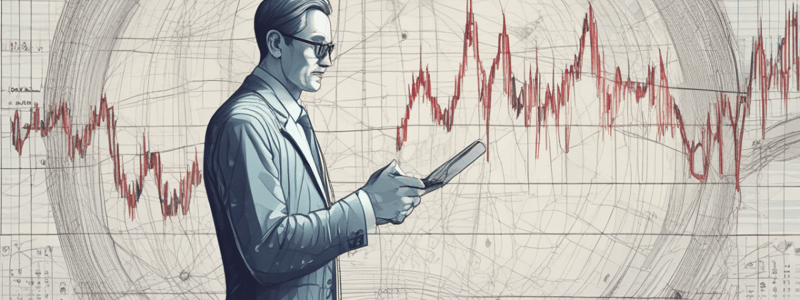Podcast
Questions and Answers
What is the primary purpose of trendlines in finance?
What is the primary purpose of trendlines in finance?
- To determine the liquidity of a financial market
- To calculate the rate of return on an investment
- To predict future price movements and make informed trading decisions (correct)
- To identify the exact price of an asset at a given time
What type of trendline connects two or more low points on a price chart?
What type of trendline connects two or more low points on a price chart?
- Downward Trendline
- Sideways Trendline
- Upward Trendline (correct)
- Horizontal Trendline
Why are trendlines considered subjective?
Why are trendlines considered subjective?
- Because they are only used in technical analysis
- Because different traders may draw them differently based on their interpretation of the chart's price action (correct)
- Because they are only used in long-term trading
- Because they are based on fundamental analysis
What is the name of the trendline that connects two or more high points on a price chart?
What is the name of the trendline that connects two or more high points on a price chart?
What is the recommended approach to using trendlines in trading decisions?
What is the recommended approach to using trendlines in trading decisions?
What is the primary purpose of volume analysis in finance?
What is the primary purpose of volume analysis in finance?
Which reversal pattern is the mirror image of the head and shoulders pattern?
Which reversal pattern is the mirror image of the head and shoulders pattern?
What is the main difference between continuation patterns and reversal patterns?
What is the main difference between continuation patterns and reversal patterns?
What is the term for the comparison of current volume to historical average volume for the same asset?
What is the term for the comparison of current volume to historical average volume for the same asset?
What is the primary purpose of using price patterns in conjunction with other technical analysis tools?
What is the primary purpose of using price patterns in conjunction with other technical analysis tools?
Which type of gap typically occurs near the end of a trend and signals that the prevailing trend is losing momentum?
Which type of gap typically occurs near the end of a trend and signals that the prevailing trend is losing momentum?
Which of the following is NOT a characteristic of volume analysis?
Which of the following is NOT a characteristic of volume analysis?
What is the primary characteristic of a breakaway gap?
What is the primary characteristic of a breakaway gap?
What is the term for the formation or arrangement of price movements on a chart that traders and analysts use to predict future price movements?
What is the term for the formation or arrangement of price movements on a chart that traders and analysts use to predict future price movements?
Why are gaps significant in financial markets?
Why are gaps significant in financial markets?
Which component of a bar chart provides information about the financial instrument's initial price at the start of the time period?
Which component of a bar chart provides information about the financial instrument's initial price at the start of the time period?
What does a bearish engulfing pattern typically indicate?
What does a bearish engulfing pattern typically indicate?
What is the purpose of using additional technical analysis tools and indicators in bar pattern analysis?
What is the purpose of using additional technical analysis tools and indicators in bar pattern analysis?
What does an inside bar pattern often indicate in the market?
What does an inside bar pattern often indicate in the market?
Why is it important to use bar patterns in conjunction with other forms of analysis and risk management techniques?
Why is it important to use bar patterns in conjunction with other forms of analysis and risk management techniques?
Flashcards are hidden until you start studying
Study Notes
Trendlines
- Graphical representations used to analyze the direction and strength of price movements in financial markets over time
- Created by connecting two or more significant price points on a chart, usually using a straight line
- Help traders and analysts identify patterns, predict future price movements, and make informed trading decisions
- Two main types of trendlines: upward (support line) and downward (resistance line)
Upward Trendline
- Connects two or more low points on a price chart
- Indicates that the asset's price is trending upward over time
- Seen as a signal to buy or enter long positions, expecting the price to continue rising
Downward Trendline
- Connects two or more high points on a price chart
- Suggests that the asset's price is trending downward over time
- Seen as a signal to sell or enter short positions, expecting the price to continue declining
Volume
- Refers to the number of shares or contracts traded for a particular financial instrument within a specified period
- Essential component of market analysis, providing valuable insights into the strength and sustainability of price movements
- Key points about volume:
- Measurement: Total number of shares or contracts traded during a given period
- Indication of market activity: High volume indicates active trading, while low volume suggests less interest and participation
- Confirmation of price movements: Volume often confirms the validity of price movements
- Volume patterns: Traders and analysts study volume patterns to identify potential trends or reversals
- Relative volume: Compares current volume to historical average volume for the same asset
Price Patterns
- Recognizable formations or arrangements of price movements on a chart used to predict future price movements
- Classify into two main categories: continuation patterns and reversal patterns
- Can occur on various timeframes, ranging from intraday charts to long-term charts
Continuation Patterns
- Suggest that the prevailing trend is likely to continue after the pattern completes
- Examples: Flag, Pennant, Rectangle
Reversal Patterns
- Indicate a potential change in the prevailing trend
- Examples: Head and Shoulders, Double Top/Double Bottom, Inverse Head and Shoulders
Gap
- Discontinuity or "empty space" on a price chart where there is a significant difference between the closing price of one trading session and the opening price of the subsequent session
- Occurs when there is no trading activity, typically due to a sudden change in market sentiment or significant news events
- Types of gaps: Common Gap, Breakaway Gap, Exhaustion Gap, Continuation Gap
- Gaps provide valuable information to traders and analysts about market sentiment, potential price movements, and levels of support and resistance
Bar Patterns
- Visual representation of price movements over a specific time period on a bar chart
- Components of a bar: Open, High, Low, Close
- Interpreting bar patterns: Traders and analysts use bar patterns to analyze price movements and identify potential trading opportunities
- Examples: Engulfing Pattern, Inside Bar Pattern
- Pattern confirmation: Traders often use additional technical analysis tools and indicators to confirm the validity of bar patterns before making trading decisions
Studying That Suits You
Use AI to generate personalized quizzes and flashcards to suit your learning preferences.




